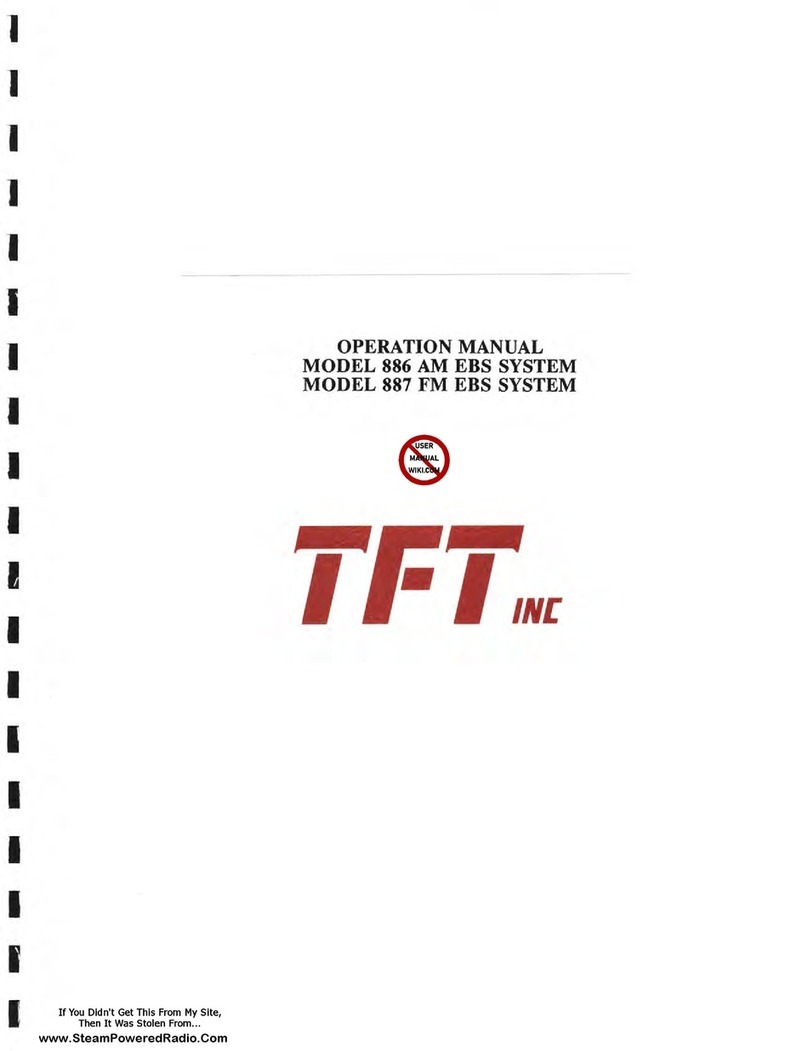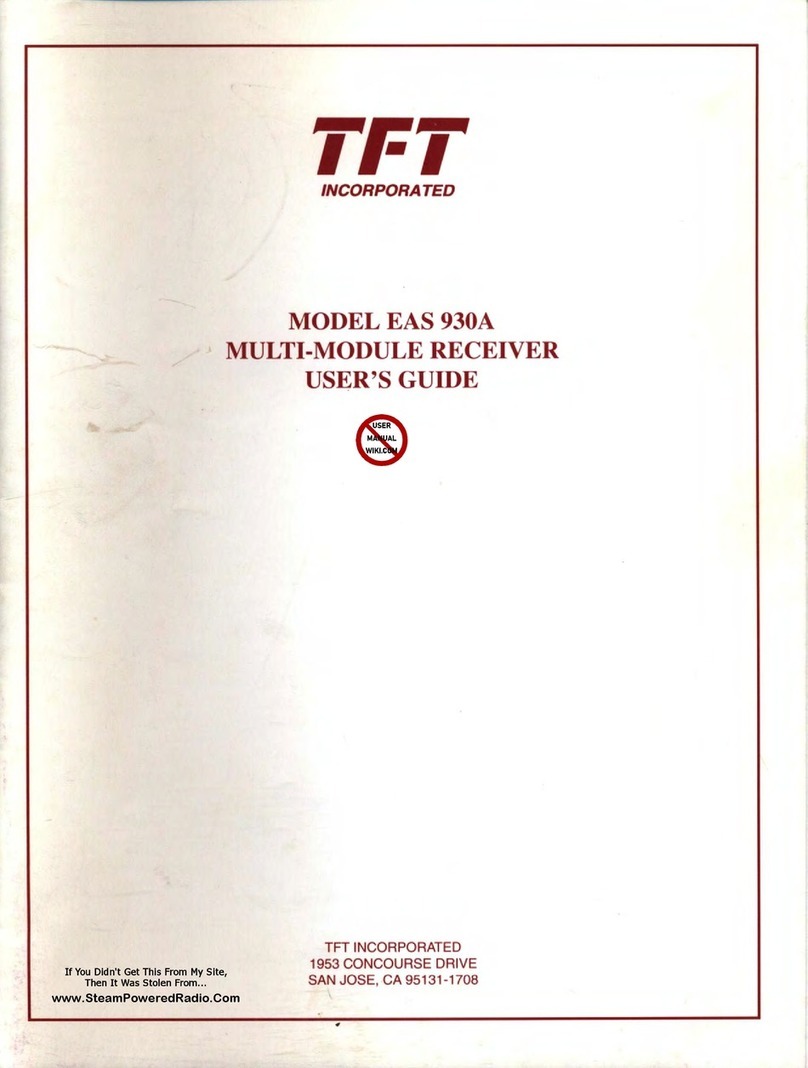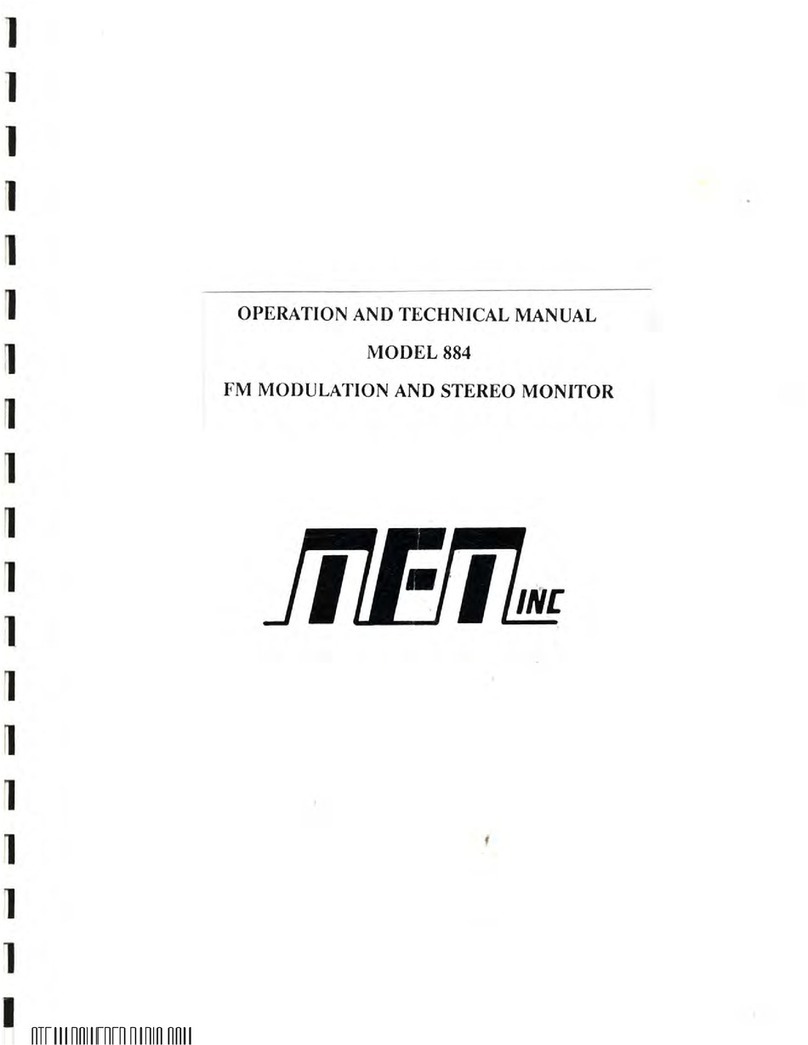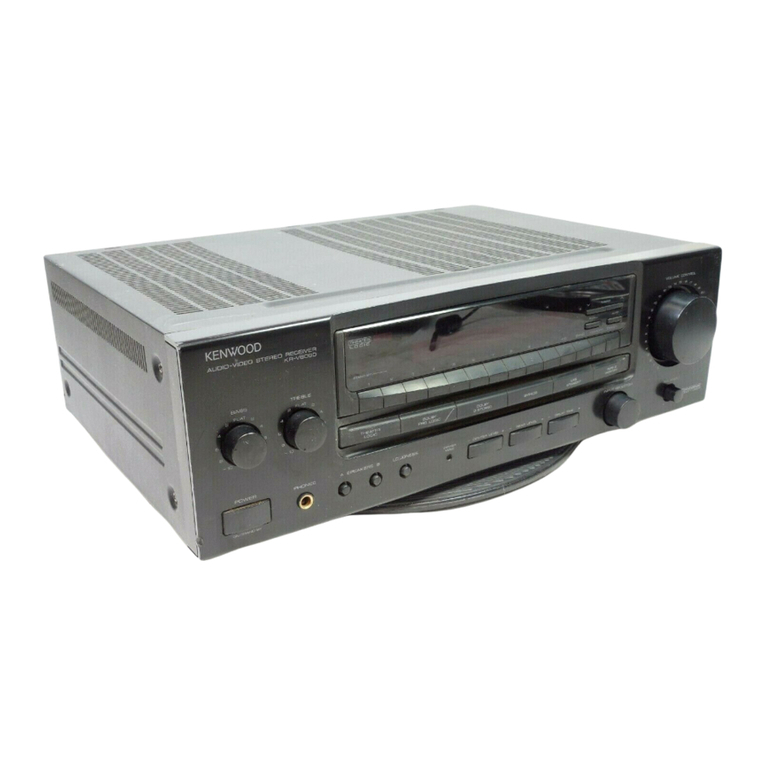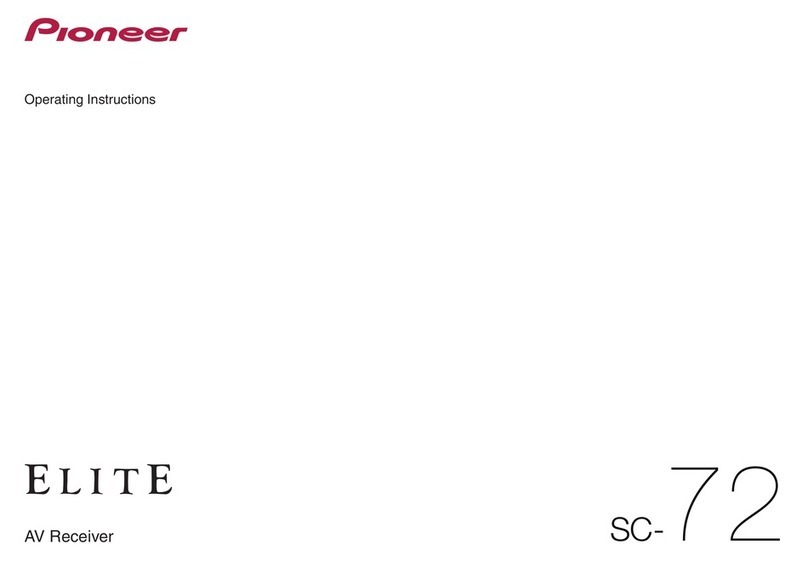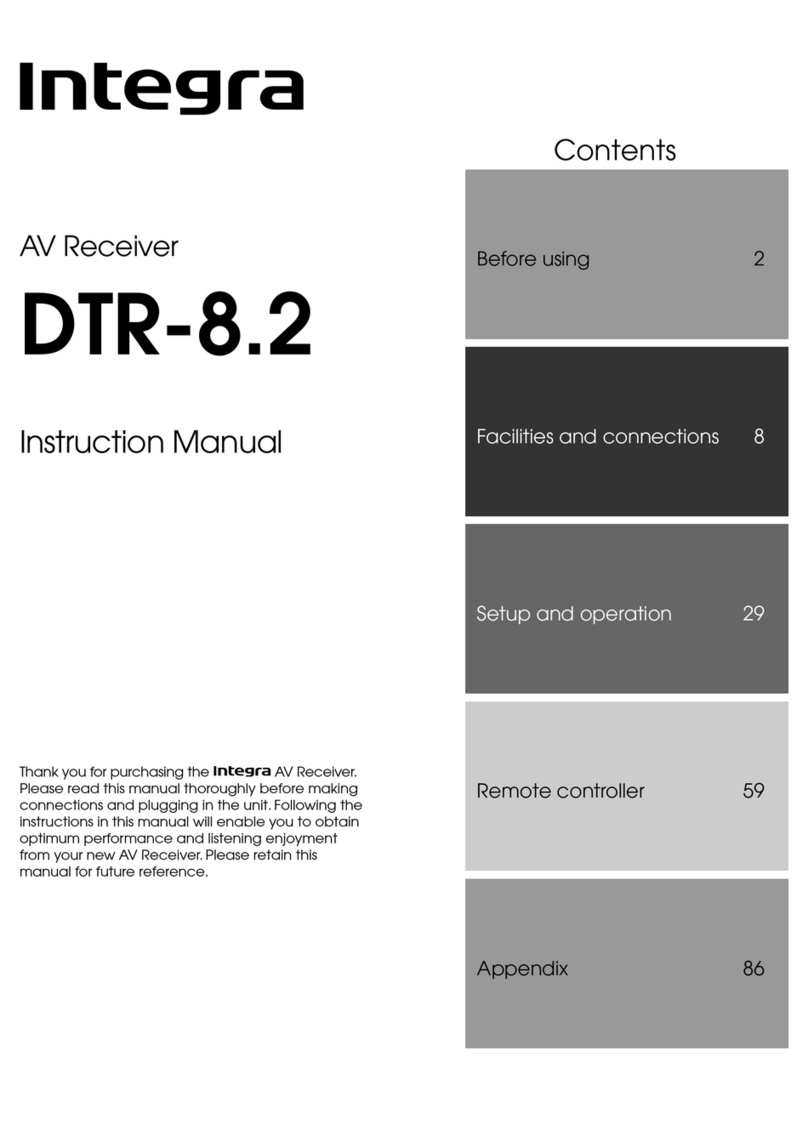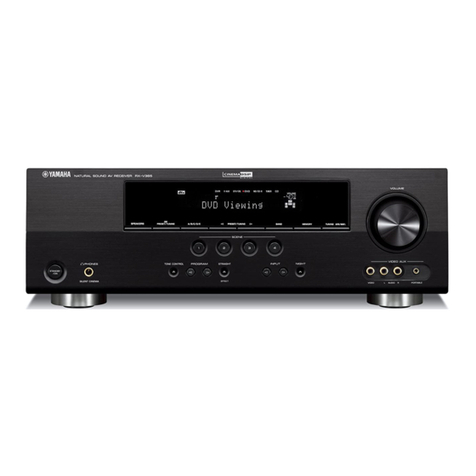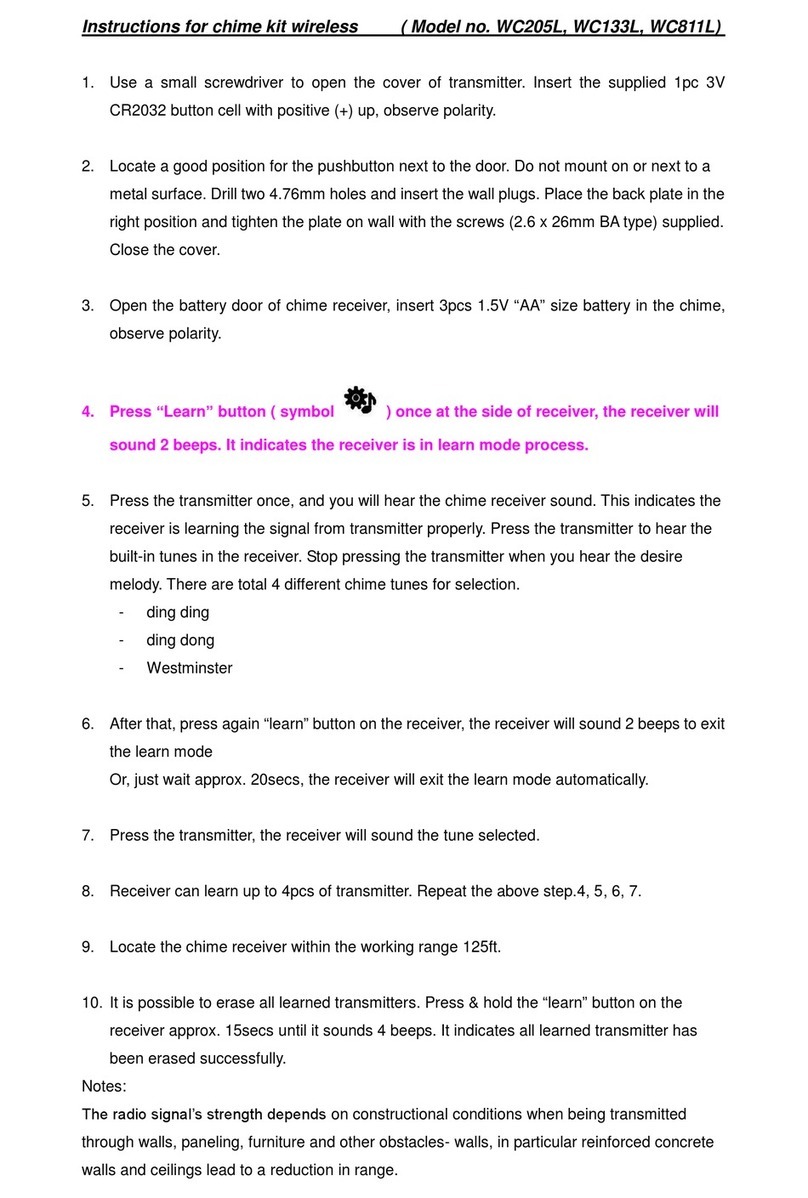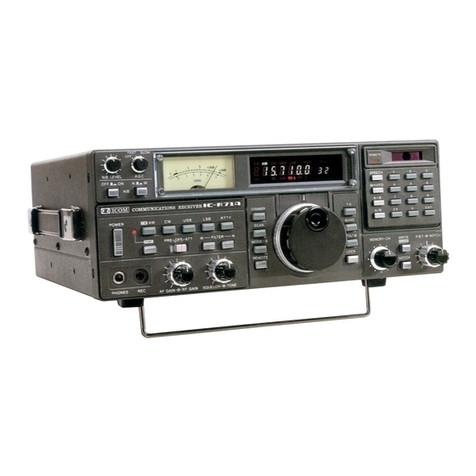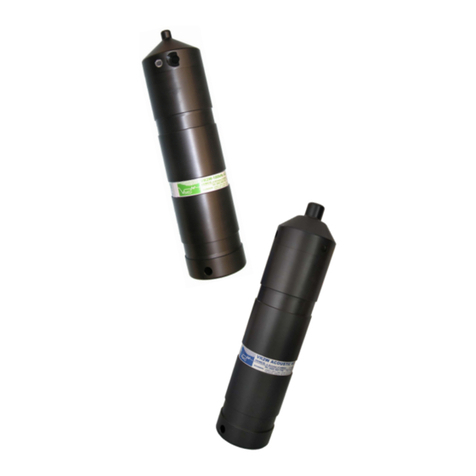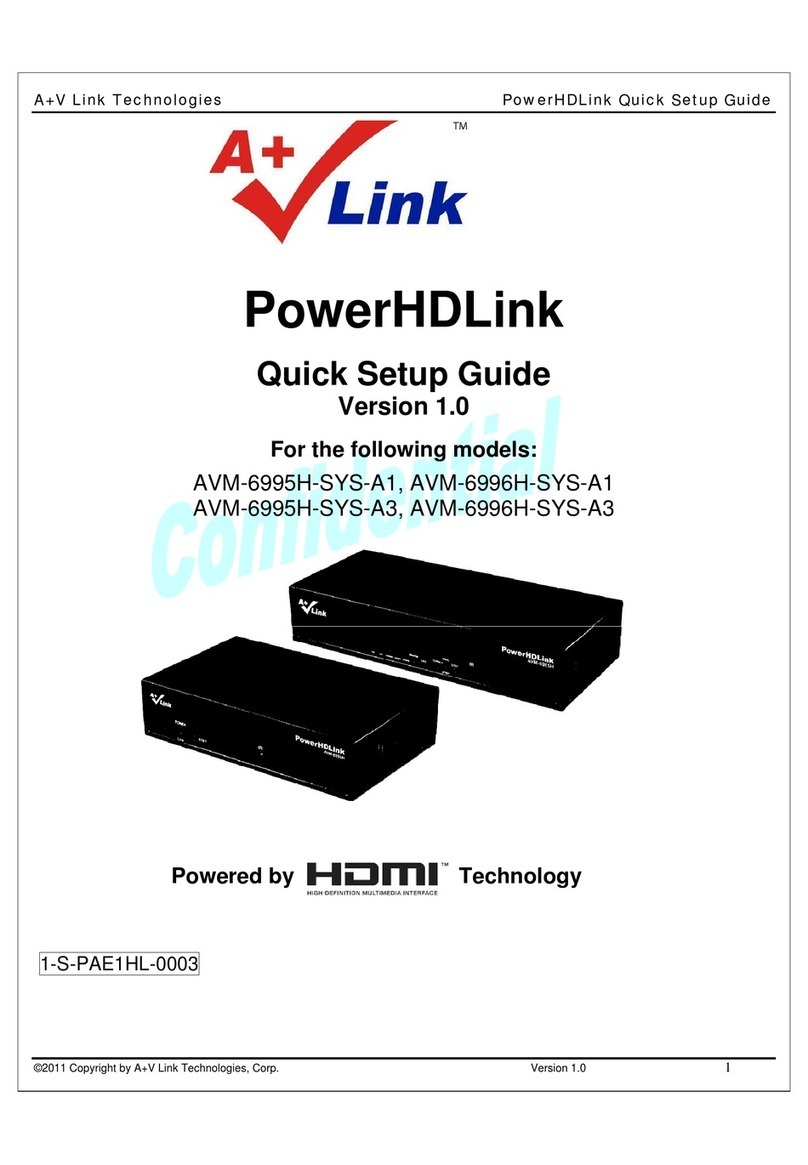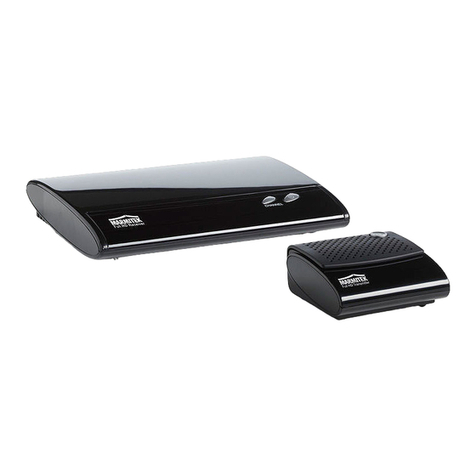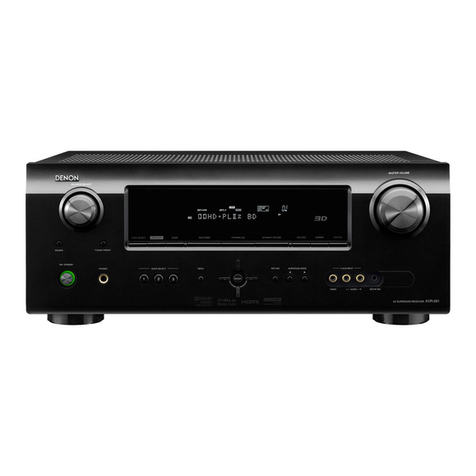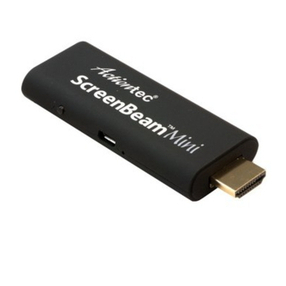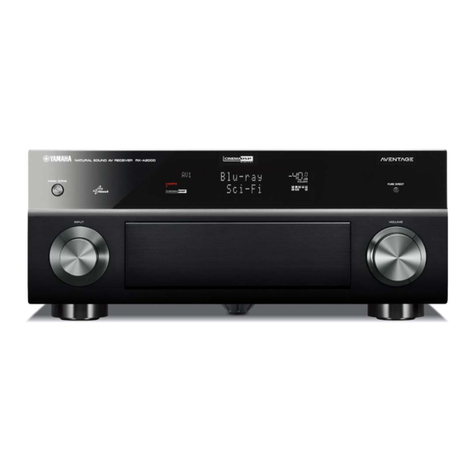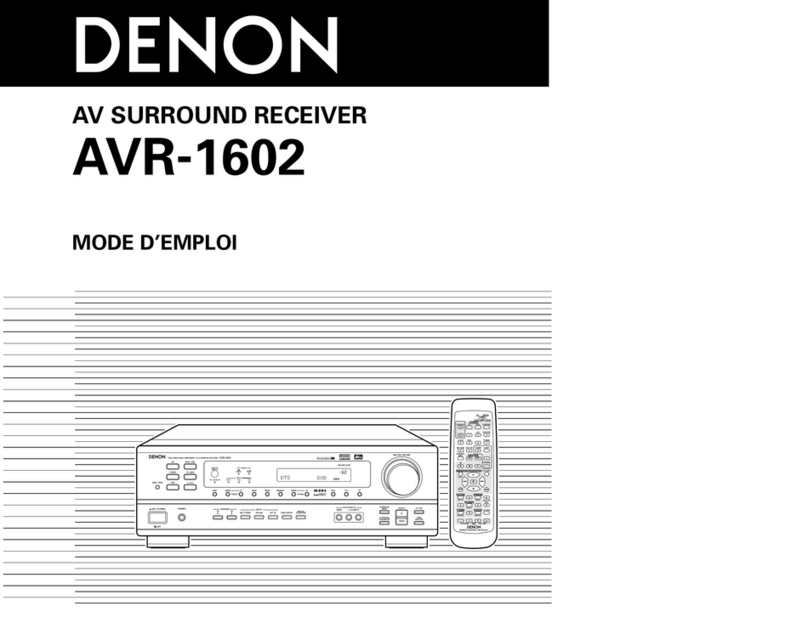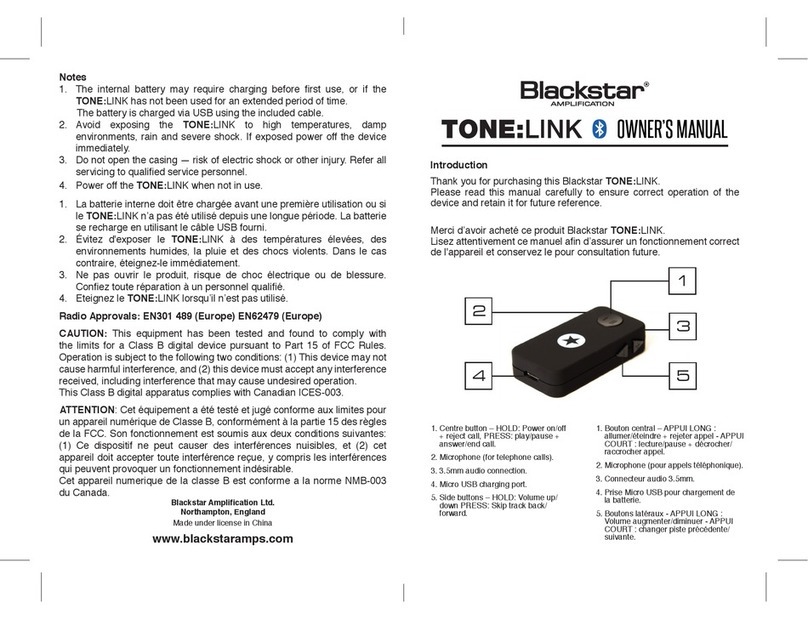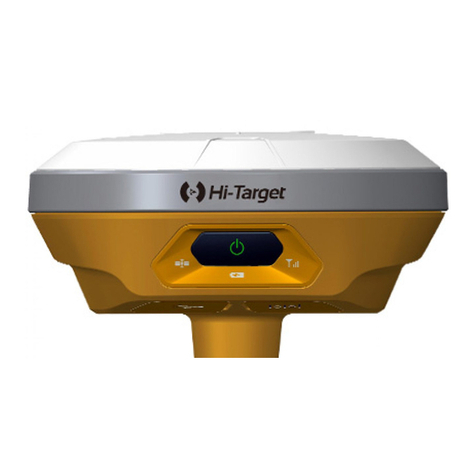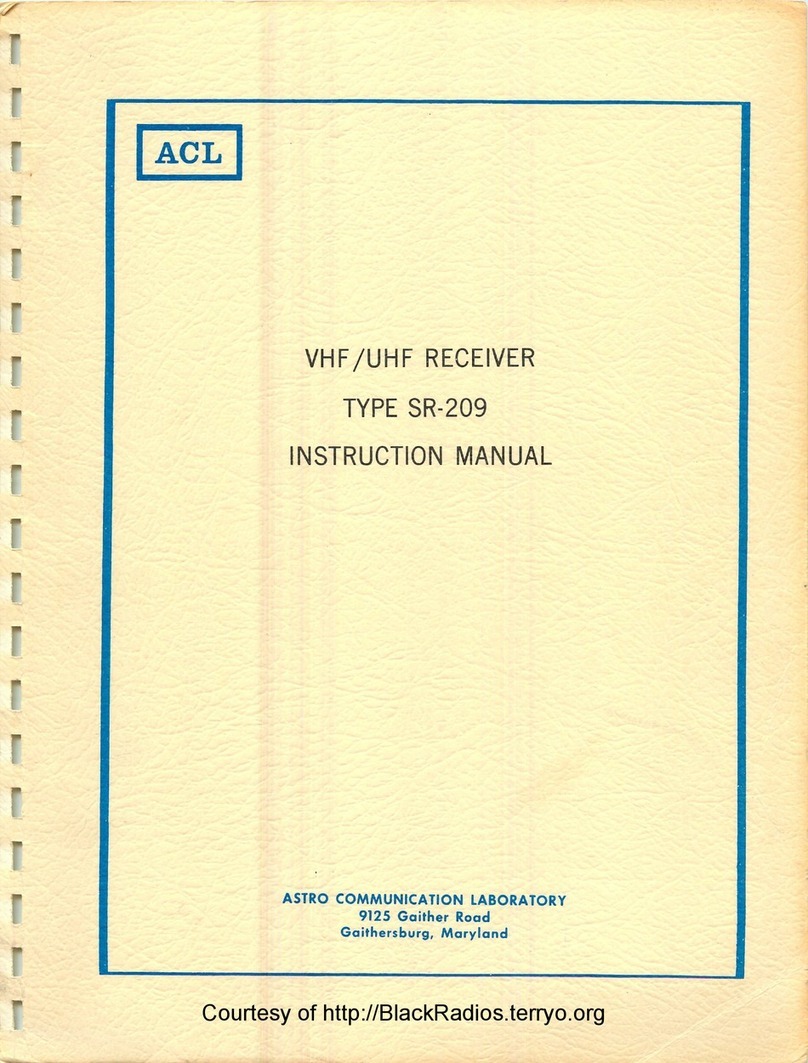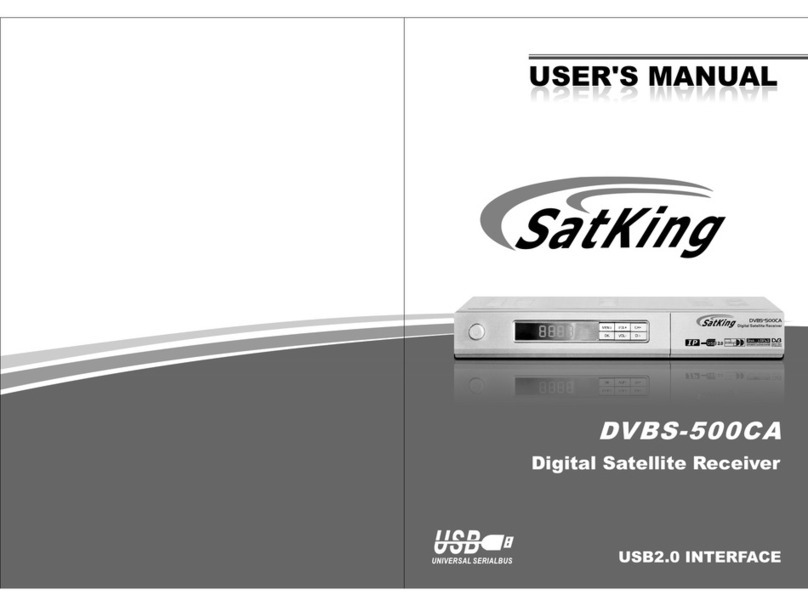TFT EBS 760 Series Service manual

www.SteamPoweredRadio.Com
Warranty
TIME
&
FREQUENCY
TECHNOLOGY,
INC.
,
warrants
each
of
the
in-
struments
of
its
manufacture
to
be
produced
to
meet
the
specificationsdelivered
to
the
BUY
ER:
and
to
be
free from defects in
mater
ial
and
workmanship
and
will
repair
or
replace,
at
its expense, for a
period
of
one
year from
the
date
of
delivery
of
equipment,
any
parts
wh
i
ch
are
defective from faulty
material
or
poor
workmanship.
I
nstruments
found
to
be
defective
during
the
warranty
periodshall
be
returned
to
the
factory with
transportation
charges
prepaid
by
BUYER.
It
is expressly agreed
that
replacement
and
repair
shall be
the
sole remedy of
BUYER
with respe
ct
to any
nonconforming
equipment
and
parts
thereof
and
shall
be
in
lieu
of
any
other
remedy
available by applicable
law
. All
returns
to
the
factory
must
be
authorized
by
TFT
,
prior
to
such
returns.
Upon
examination
by
the
factory, if
the
instrument
is found
to
be
defective,
the
unit will
be
repaired
and
returned
to
the
BUYER
,
with
transportation
charges
prepaid
by
TFT.
Transportation
charges for
instruments
found
to
be
defective within
the
first
th
i
rty
(30) days
of
the
warranty
period will be
paid
both
ways by
the
TFT.
Transportation
charges for
warranty
returns,
wherin
failure is found
not
to
be
the
fault
of
the
SELLER,
shall
be
paid
both
ways by
the
BUYER.
This
Warranty
does
not
apply
to
instruments
which, in
the
opinion
of
the
SELLER
, have
been
altered
or
misused.
NO
OTHER
WARRANTY
IS
EXPRESSED
OR
IMPLIED
.
TFT
IS
NOT
LIABLE
FOR
CONSEQUENT
I
AL
DAMAGES.
Claim for
Damage
in
Shipment
.
Your
instrument
should
be
inspected
and
tested as soon as it is received.
The
instrument
is insured for safe delivery. If
the
instrument
is
damaged
in
any
way
or
fails
to
operate
properly,
file
a
claim
with
the
carrier,
or
if
insured
separately, with
the
in-
surance company.
WE
SINCERELY
PLEDGE
OUR
IMMEDIATE
AND
FULLEST
COOPER-
ATION
TO
ALL
USE
RS
OF
OUR
PRECISION
ELECTRON
IC
I
NS
TRUMENTS.
PLEASE
ADVISE
US
IF
WE
CAN
ASSIST
YOU
IN
ANY
MANNER.
fflEffL
TIME
AND
FREQUENCY
TECHNOLOGY, INC.
3000
Olcott
St.
Santa
Clara,
CA
9 5
051
40
B
-2
4
6-
6
365
I
J
I
I
I
I
I
I
I
•
I
I
I
I
I
I
I
••
I

www.SteamPoweredRadio.Com
' .
IMPORTANT
MODEL
NO
. 760
REVISION A
Effective
Serial
No. 1000
MODEL 760 MANUAL CHANGES
2.
4
Antenna
Installation
Delete
Resistor
Figure
6-2
AM
Receiver
(Schematic
only)
AD:p X 100 KHz,.
~
1MHz
and
Xl.0 KHz
to
S1
as
Shown
SI
XIOOKt\z
I
: I
XI
Ml-12.
.
8
4
2.
I
XI
-z.
•, · .·.
•·
•l
,
Figure
6-3
., 1
FM
Receiver
(Schematic
only) .
1 , • •
ADD:
Line
from
the
junction
of
Zl-6
'
and
R43
to
center
tap
of
L3
·'
!
-'.
Figure
6-:-4
Tone
Generator
(Schematic
&
Material
List)
. ,Change: .
C2
lO00pf
Part
No. 1005-1000
to
a 1200pf
Part
No.
1007-0012
Figure
6-5
Tone
Decoder
(Schematic
&
Material
List)
REMOVE:
Fl
a 2A
Slo
Blo
Fuse,
Part
No
.
1900-0002,
Replaced
with
a
jumper
Figure
6-6
Dual
Purpose
Decoder
(Schematic
&
Material
List)
REMOVE:
Fl
a
2a
Slo
Blo
Fuse,
Part
No.
1900-0002,
replaced
with
a
jumper
CHANGE: P .
C.
Board
No. 6609-0970
to
6608-0970
CHANGE: Switch
Sl,
reverse
nomenclature
of
LISTEN/OPERATE
CHANGE: On
Material
List
Z3
to
a 74132
Part
No.
1100-4132
CHANGE: On
Schematic
C27
from
a 7000µf
capacitor
to
a8000µf
capacitor

www.SteamPoweredRadio.Com
-.,,,--,.._
IMPORTANT
MODEL
760 MANUAL CHANGES
MODEL
NO.
7G0
REVISION B
Effective
Serial
No
. 1000
2.
4
Antenna
Installation
Figure
6-2
Sl
Figure
6-3
Figure
6-4
Figure
6-5
Figure
6-6
Figure
2-1
Delete
Resistor
AM
Receiver
(Schematic
and
Material
List)
ADD X 100
KHz,
X
1MHz
and
XlO
KHz
to
Sl
as
Shown
8
4
2
I
')(\00
1(1,1-z.
t
')(.\MHZ.8
4
'l
I
X
10
\(~?.
Change:
Ql
40841
Part
No.
1271-4084
to a 40673
Part
No.
1271-4067
Change:
R14
330Q
Part
No
.
1065-0330
to
a 240
QPart
No.
1065-0240,
factory
select.
FM
Receiver
(Schematic
only)
ADD:
Line
from
the
junction
of
Zl-6
and
R43
to
center
tap
of
L3
Tone
Generator
(Schematic
&
Material
List)
Change:
C2
l000pf
Part
No.
1005-1000
to
a 1200pf
Part
No.
1007-0012
Tone
Decoder
(Schematic
&
Material
List)
REMOVE:
Fl
a
2A
Slo
Blo
Fuse,
Par
t
No.
1900-0002,
replaced.
with
a
jumper
Dual
Purpose
Decoder
(Schematic
&
Material
List)
REMOVE:
Fl
a
2A
Slo
Blo
Fuse,
Part
No
.
1900-0002,
replaced
with
a
jumper
CHANGE:
P,
C.
Board
No.
6609-0970
to
6608-0970
CHANGE:
Switch
Sl,
reverse
nomenclature
of
LISTEN/OPERA
TE
CHANGE:
On
Material
List
Z3
to
a 74132
Part
No.
1100-4132
CHANGE: On
Schematic
C27
from
a 7000µf
capacitor
to
a 8000µf
capacitor
CHANGE:
As
Shown
Below
TFT
MODEL
760
K1:
POTTER
&
BRUMFIELD
R10-E1-Y2-
V185. TOTAL
RELAY
CURRENT
MUST
NOT
EXCEED 250
mA
.

www.SteamPoweredRadio.Com
-
..........
APPLICATION
BULLETIN:
75-02
TO:
Model 760 EBS
System
Users
FROM:
F.
Stolten,
Customer
Service
Manager
DATE:
December
15,
1975
SUBJECT:
Automatic
Reset
of
Two-Tone
Generator
TFT
has
recently
received
inquiries
from
the
field
requesting
information
on
how
to
modify
the
Model
760-04
Two-
Tone
Generator
to
make
the
RESET
automatically
function
after
the
23. 5
second
two-tone
transmission
period.
This
change
is
desired
because
some
broadcasters
want
to
make
EBS
announcements
on
their
nprmal
program
line
and
thus
do
not
want
to
manually
reset
the
Two-
Tone
Generator
after
each
tone
transmission
before
making
Emergency
announccments
-
-or
maybe
forget
to
reset??
There
are
several
ways
to
implement
the
automatic
reset.
. One
way
is
to
modify
the
generator
directly.
This
is
done by
removing
C20,
lµf,
and
placing
a
0.
22µ.f
capacitor
between
Z3
pin 11 and
Zl
pin
13.
An
alternate
approach
to
automatically
rcsef
the
generator
would
be:
1.
Do
not
route
the
normal
program
audio
through
Kl
on
the
Two-Tone
Generator.
2.
Connect
a
pair
of
lines
from
the
AUDIO
OUTPUT
terminals
of
the
Two-
Tone
Generator
to a
mixer
on
the
audio
console
.
.
This
would
inject
the
,
two-tone
's
on
the
program
iine
without
interrupting
it.
However,
the
Generator
must
be
reset
either
manually
or
automatically
before
the
next
tone
transmission.
. ;
..
.
.
I •
r
':-,
.
',J;
r
I •
,.
..
II
•
r
1
'I
.
..
,
..
..

www.SteamPoweredRadio.Com
Sect.Ion
'1
Table
af
Cant:ent:s
caeneral
Informal.Ion
1.1
General
Description
......................................
.
...............
.
1.2
Specificaitons
...................
....
...
..........
....
....
.
...............
.
7.2.1 Model 760-07
AM
Receiver
......
.
......................
...
......
.
.......
.
1.2.2 Model 760-02
FM
Receiver
.
......
.
..
.
..........
.
........
. .
..
...
.
.........
.
7.2.3 Model 760-03 Tone
Decoder
.............
.
......
.
..
.
...
. . .
..
.
...
.
.........
.
Page
1-1
1-1
1-1
1-1
1-2
1.2.4 Model 760-04 Two-Tone
Generator......
. . .
....................
.
...
......
.
..
1-2
7.2.5 Model 760-05 Dual
Purpose
Decoder..........
.
.................
. . .
..........
1-2
Sect.Ion
12
lnat.allat.lon
2.1
Unpacking
and
Inspection
. . . . . . . . . . . . . . . . . . . . . . . . . . . . . . . . . . . . . . . . . . . . . . . . . 2-1
2.2
Power
Requirement
. . . . . . . . . . . . . . . . . . . . . . . . . . . . . . . . . . . . . . . . . . . . . . . . . . . . . . . 2-1
2.3
Installation
and
Hookup
. . . . . . . . . . . . . . . . . . . . . . . . . . . . . . . . . . . . . . . . . . . . . . . . . . . 2-1
2.3. 7
Receiver
AM
or
FM
. . . . . . . . . . . . . . . . . . . . . . . . . . . . . . . . . . . . . . . . . . . . . . . . . . . . . 2-1
2.3.
7d
External Carrier Fail Alarm . . . . . . . . . . . . . . . . . . . . . . . . . . . . . . . . . . . . . . . . . . . . . . 2-1
2.3.2 Two-Tone
Generator
. . . . . . . . . . . . . . . . . . . . . . . . . . . . . . . . . . . . . . . . . . . . . . . . . . . . . 2-1
2.3.2b Combined
AM/FM/TV
Operation . . . . . . . . . . . . . . . . . . . . . . . . . . . . ... . . . . . . . . . . . 2-1
2.3.3 Tone
Decoder
. . . . . . . . . . . . . . . . . . . . . . . . . . . . . . . . . . . . . . . . . . . . . . . . . . . . . . . . . . 2-1
2.3.4 Dual-Purpose
Decoder
. . . . . . . . . . . . . . . . . . . . . . . . . . . . . . . . . . . . . . . . . . . . . . . . . . . . 2-3
2
.4
Antenna
Installation
2-4
Sect.Ion
3
Dperaclon
Sect.Ion
4
Section
15
3.1
General
......
...
.
...
....
.
.........
.
............
.
....
...
. .
...............
.
3.2
AM
Receiver
...................
. .
........
.
............
.
......
.
.....
.....
.
3.3
FM
Receiver
.........
.
....
.
...
.
....
. . .
..................
.
..........
.
.....
.
3.4
Two-Tone
Generator
...
.
.........
. . . . . .
..........
.
....
. . . .
..
............
. .
3.4.1 Basic Operation
........
.
..............
.
......................
..
........
.
3.4.2 Remote Control .
......
.
..........
..................
...........
. . .
..
.....
.
3.4.3 External Audio Switching .
............
...
. .
.....
.............
.
...
.
..
. . .
...
.
.3.5
Tone
Decoder
...................................
.
......................
. .
3.6
Dual
Purpose
Decoder
..
.
......
.
.....
...........
..
.....
.................
. .
Theory
of
0peraclon
4.1
System
.......................
.
........
.
........
.
......
. . .
....
.
..........
.
4.2
AM
·
Receiver
............................................................
.
4.3
FM
Receiver
.......
.
.........
.
...
....
...
.
...............
. .
..
......
.
..
. . . . .
4.4
Two-Tone
Generator
................
. . .
...........
.
..
.
....
.
......
...
.....
.
4.5
Tone
Decoder
..................................
.
..............
.
.........
.
4.6
Dual
Purpose
Decoder
Malncenanca
5.1
General
...................
.
..........
.
....
.
.....
.
....................
...
.
3-1
3-1
3-1
3-1
3-1
3-1
3-1
,3-1
3-2
4-1
4-1
4-1
4-1
4-2
4-2
5-1
5.2
Periodic
Maintenance
. . . . . . . . . . . . . . . . . . . . . . . . . . . . . . . . . . . . . . . . . . . . . . . . . . . . . 5-1
5.
.3
Performance
Checks........
.
........................
.
...........
. .
..
...
.
..
5-1
5.3.1
AM
Receiver
. . . . . . . . . . . . . . . . . . . . . . . . . . . . . . . . . . . . . . . . . . . . . . . . . . . . . . . . . . .
5-1
5.3.2
FM
Receiver............
.
........................
. . . .
...........
.
......
5-1
5.3.3 Tone
Decoder
. . . . . . . . . . . . . . . . . . . . . . . . . . . . . . . . . . . . . . . . . . . . . . . . . . . . . . . . . .
5-1
5.3.4 Two Tone
Generator
. . . . . . . . . . . . . . . . . . . . . . . . . . . . . . . . . . . • . . . . . . . . . . . . . . . . . 5-1
5.3.5 Dual
Purpose
Decoder
. . . . . . . . . . . . . . . . . . . . . . . . . . . . . . . . . . . . . . . . . . . . . . . . . . . . 5-2
Section
B
Schematic
Diagram•
6.1
Block
Diagram
6.2
AM
Receiver
.,.......,.,_
*6.3
FM
Receiver
6.4
Two-Tone
Generator
6.5
Tone
Decoder
*6.6
Dual
Purpose
Decoder
*These Diagrams
are
only included when applicable.

www.SteamPoweredRadio.Com
Section
1
General
Information
1.1
General
Description.
The
TFT
EBS System
is
designed to meet the
FCC
Two-Tone
EBS interstation signal
ing
require-
ments. It normally consists
of
three modules-
the
model
760-04
Two-Tone
Generator,
the
Model 760-01
AM
Receiver
or
the
Model 760-02
FM
Receiver,
and
the
Model 760-03
Tone
Decoder-
mounted
in
a
cabinet
for
installation in a 19-i
nch
relay rack.
1.2
Specifications.
EBS
Cabinet
Assembly
Module
Capacit
y
..............
.
.....
....
.
Input
Power*
....
, . .
..
.
...
.
....
.
...
..
. . . .
Operating
Temperature*
.........
.
...
. . . . .
Operating
Humidity*
................
.
...
.
Size
.....
..
.....
....
.
......
.
......
...
..
.
Weight .
......
. .
..
..............
. . .
...
. .
7.
2.
7
Model
760-07,
Frequency-Synthesized
AM
Recei
ve
r
FrequencyRange
......
.
....
.
....
.. ..
. . . . .
Local OscillatorStability
.............
• . .
..
Tuning
Method
...
............
.
.......
. . .
Antenna
Input
...........
.
..............
.
Sensitivity .
...
................
..
. .
..
....
.
Image Rejection
......
.
.................
. .
AGC
..
.........
.
......
.
.......
.
.......
.
IF
Bandwidth, 6dB . .
...
.
....
...
. .
..
.....
.
Harmonic
Distortion
...
...
..
.....
. .
......
.
Noise
...
.
......
..
.
.................
. . . . .
Audio
Outputs
, 600
ohms
...............
. . .
Carrier-Off
Output
..
. . .
...
. .
.........
,
..
.
7.2.2
Model
760
-
02,
Crystal
Controlled
FM
R
ece
i
ver
FrequencyRange . ,
.......
. .
............
. .
Channel Frequency . .
....
...
..........
.
..
.
Antenna
Input
.
....
.
...
..
. .
...
......
...
. .
Sensitivity
....
.......
.
..
•.
...
.
..........
.
IFBandwidth, 6dB
...
.
..
.
...............
.
Image Rejection
.....
...
. . . .
.......
.
...
. . .
AGC
.
......
.
.....
................
.
....
.
Audio Frequency Response
.....
.
....
...
...
.
Harmonic
Distortion
.....................
.
S/N
Ratio
........
. .
..
...
..
...
. . .
.......
.
*Specifications
apply
to
all system modules.
1-1
An emergency two-tone signal received from
the
AM
or
FM
station
being monitored will be
heard
on
the
EBS System
speaker
after
such
a tone has been received
for
at
least 8 seconds.
The
EBS System provides the
means for interruptingnormal
programming
and
broad
-
casting
the
two-tone emergency signal for 23.4 seconds,
and
for
inserting
emergency
announcements. Normal
operation
can
be restored by
operation
of
two reset
switches.
willaccept
up
to
three
EBSmodules (Models 760-01, -02,
-03, -04,
and
-05). Blank panels
are
provided when fewer
th
an
three
modules
are
in
use.
117
VAC
±
15
%,
50/60
Hz
, 20 watts maximum.
0 °
to
50
°C.
95% Relative..
3.5"
(8.9 cm) high x
19"
(48.3
cm
) wide x
12"
(30.5 cm)
deep.
Approx. 10
pounds
(4
.5 kg)
540-1620
kHz
±500
Hz
per
year
Channel
frequency digitally set m 10
kHz
steps by
thumbwheel switches.
75
ohms
nominal, unbalanced.
30
µ V for 20 dB
S/N
at
30% modulation.
SO
dB
70
dB
±5
kHz
Less
than
3%
at
90% modulation.
45
dB
or
greaterbelow100%modulationwith 10
MV
RF
Balanced:
+8
dBm. Unbalanced: 1 V
rms
Active pullup
to
10
V, 10
ma
88-108
MHz
Speci
fy
frequency, either
one
or
two channel versions
available.
75
ohms
nominal, unbalanced.
2 µ V for 30 dB
of
quieting.
±150
kHz
40 dB
80 dB
±1
dB, 50
Hz
-15
kHz
1%
60
dB
or
greater below 100% modulation
at
SO
µV
RF
i
nput

www.SteamPoweredRadio.Com
I
••
I
I
I
I
I
I
I
~
I
I
I
I
I
De-emphasis
..........................
. . .
Audio
Outputs,
600
ohms
....
.
..
.
.........
.
Carrier-Off
Output
............
.
..
.
...
...
.
1.2.
3 Model
760-03,
Two-Tone
Decoder
Input
Le
vel
Requir
ed
..
.....
......
..
.....
. .
Tone
Frequencies"'*
.......
..
.....
.
......
. .
Bandwidth**
.....
.....
......
. .
....
.....
.
Listen
Operate
Switch
.........
.
..........
.
Audio
Output
..............
.
..
.
....
.
..
..
.
Re
set Switch
...........................
. .
Remote
Operation
.......................
.
Time
DelayforDe-muting"'* .
...
.
.........
.
External
Alarm
Cont
ra
cts
.................
.
1.2
.4 Model
760-04
, Two-Tone
Generator
Output
Frequencies"'* . .
......
..
..........
.
Frequency Accuracy*"'
...................
.
Output
Level
...........
.
.....
.
..
.
......
.
Output
Impedan
ce
............
..
........
.
Harmoni
c Distortion"'*
.........
.
.........
.
Tone
Duration••
....
..........
.
.......
..
.
Tone
Level Adjust**
.............
.
.......
.
Program Audio Routing
.....
.
.. ..
.....
...
.
Emergency
Program
Audio I
nput
...
.
................
......
.
Test
Switch
...
.
...........
.
............
. .
Tone
Switch
......
.
.....
.......
. . . .
.....
.
Command
Switches
...
•
...................
ResetSwitch ,
.......
.
................
..
. .
Remote
Operation
. . . •
........
. .
..........
l.2.5 /lfudel
760-05,
Dual-Purpo
se
Decoder
75 µ sec
Balan
ced:
+8
dBm.
Unbalanced:
I V
rms
Active
pullup
to
IOV,
10ma.
l00 mV into 600
ohms
053
Hz
and
960
Hz
±5
Hz
In
Operate
mode
the
loudspeaker
is
muted
until
an
EBS
alert
is decoded.
fn Listen mode,
the
loudspeaker
is
demuted
.
I
Watt,
in
ternal
loudspeaker
Resets
decoder
and
mutes loudspeaker
The
RESET
switch wiring is
brought
out
to
the rear
panel.
12
seconds
±4
seconds
SPOT
relay contacts brought
out
to
rear
panel.
853
Hz
and
960
Hz
±0.25
Hz
, crystal controlled
+8
dBm
nominal (per tone)
600
ohms,
balanced
Less
th~n
2%
23.4 seconds,
±0.15
seconds
Front
panel
pot,
-2
dBm
to
+8
dBm
Rear
panel
DPDT
relay contacts. Balanced
input
and
output.
Switchover
and
latch
to
EBS
programming
is
automatic.
Unbalanced
input.
Internally
inserted into
program
line.
Connects
Generator
to De
coder
for testing without inter-
rupting
program
audio.
Enables
one
tone
at
a time for setting level
and
checking
distortion.
2 toggle switches.
Must
be
activated in opposite direc-
tions
to
turn
on
Generator
.
Releases
latch
to restore
normal
program
audio.
The
COMMAND
and
RESET
switch wiring is
brought
to
the
rear
panel.
See
M
ode!
760
-
03,
T
wo
-Tone
Decoder
for
Two-
Tone
Spec1fications
CarrinBrf'ak/
J(XX}
H{Speczfzcations:
Input
Le
vel
Required
...................
..
.
Tone
Fr
equency
...
....................
. . .
B
andwidth
.....
.
......
............
. .
...
.
Time
to
demute
after
start
of
Carrier
Breaksequence
.............
..
.......
. .
..
.
RE
SET
switch
........................
..
.
Listen/Operate
Switch .
........
........
. . .
Audio
Output
.............
.
...........
. . .
Remote
Operation
. .
.............
.
.......
.
External Alarm
Contacts
......
.
..
..
.......
.
100 mV into 600 ohms
1000
Hz
±50
Hz
23
to
27
sec.
Resets decoder
and
mutes
loudspeaker.
fn
Operate
mode
the
loudspeaker is muted until
an
EBS
alert
is
decoded. In List
en
mode
the
loudspeaker is
demuted.
1
Watt
,
internal
loudspeaker
The
RESET
switch
is
brought
out
to
the
rear
panel.
SP
OT
relay contacts
brought
out
to
rear
panel.
Specifications
are
typical except those identified by ** which
are
guaran
teed.
1-2

www.SteamPoweredRadio.Com
Section
2
Installation
2.1 Unpack
ing
and
Inspection.
Upon
receiving
the
instrument, inspect
the
packingbox
and
instrument
forsi
gns
of
possible
sh
i
pping
damage.
Operate
the
instrument
in
accordance
with
the
procedures
of
Section3
of
this
manual.
If
the
instrument
is
damaged
or
fails
to
opera
te
properly, file a claim
with
the
t
ransportation
company,
or
with
the
insurance com-
pany
if insured
separate
ly.
2.2
Power
Requirements.
The
Model 760
EBS
System
operates
from a
117-volt Ac Source.
The
line frequency
must
be
between
50
and
60
hertz.
Maximum
power
requ
i
red
is 20 watts.
2.3 Installation
and
Hookup.
When
the
EBS
System
Cabinet
assemb
ly is
mounted
in a 19-inch relay
rack
with
all modules in
place,
make
the
following connections
to
the
module
terminalstripsat
the
rear
of
the
cabinet. Afterall connec-
tions have
been
made,
plug
the
power
cord
into a 117-
volt, 60-hertz source.
There
is
no
power switch in
the
system: it is energized wheneverits power
cord
is
plug
g
ed
m.
2.3.7 R
eceiver
AM
or
FM.
2.3.2
ii-
a.
If
an
AM
or
FM
Receiveris installed,
connect
a
75
ohm
coax cable from the
antenna
to
the
rear-panel
ANTENNA
connector.
,.~
b.
Connect
the
rear-panel
UNBAL
AUDIO
terminal
to the
DECODER
AUDIO
I
NPUT
terminal.
c.
If
desired,
the
rear-pan
el
BALA
NCE
D
AU
DIO
t
erminals
can
be
connected
to
a
monitor
or
other
device.
Output
at
these
terminals is
+8dBm
at
600
ohms
for 100%
modulation.
d.
ff a remote indication of
car
rier fail
ure
is
to
be
provided, connect
the
rear-panel
CARRIER
FAIL
termina
l
to
the
remote indicator.
Output
from
th
is terminal
is+
10 volts @ 10
ma
for
normal
carrier
level,
and
O volts wi
th
5
ma
current
sinking for
car
rier
failure. For
operating
an
external
carrier
fail
ala
rm relay, see Figure2-
1 for suggested circuit. Total external relay
current
must
not exceed 250 ma.
Two-
Tone
Generator.
a. If
the
monaural
program
audio
is
to
be
looped
through
the
Two
-
Tone
Generator,
connect the
program
input
line
to
the
rear
-panel
AUDIO
IN terminals
and
connect t
he
program
output
li
ne
to
the
rear-panel
AUDIO
OUT
term
inals.
b.
If
the
program
line
is
not
to
be
looped
2-1
TFT
MODEL
760
EXTERNA
AUDIO
RELAY
K1: POTTER
Ii
BRUMFIELD
R10-E1-
Y2
-
V185. TOTAL RELAY
CURRENT
MUST NOT
EXCEED
250
mA.
Fi
gure
2
-1
through
the
Two
-T
one
Generator,
or
if
combined
AM/FM/TV
program
audio
is
to
be
controlle
d,
external
circuitry
like
that
diagrammed
in Figure 2-2
is
recommended.
Relays
Kl,
K2,
and
K3
shown in Figure 2-2
should
have
12
-
vo
lts coils,
and
the
total coil
current
must
not exceed 250 milliamperes.
Relay power
and
EBS
audio
input
come from
connect
or
J2
on
the
rear
panel
of
the
Two
-T
one
Gene
ra
tor
.
c-~
c.
Connect
a wire from
the
rear-panel
TEST
OUT
terminal
to
the
DECODER
TEST
INPUT
terminal.
This
provides a
means
to
test
the
Two
-T
one
Generator
and
Tone
Decod
er
together without interrupting
the
program.
o
'-'-
d.
Connect
t
he
emergency
announcement
audio
line
(unba
l
anced)
to
the
rear
-panel AN
INPUT
terminal.
i~
e.
ff
remote control
of
the
command
and
reset
functions is desired,
connect
the
rear
-
pan
el
COMMAND
and
RESET
terminals
to
remote
switches.
Groundi
ng
the
se
lines activates
the
functions.
NOTE:
Pursuant
to
Section
73.940
(j
)
of
the
FCC
Rules
&
Regulations,
the
remotely
located
command
switch
must
be
guarded
such
as
to
prevent
accidental
operation
.
2.
3.3
Tone
decoder.
ti\L
a.
Connect
the rear-panel
AUDIO
INPU
T
terminal
to
the
REC
EI
VER
UN
BAL
AUDIO
as
previously
stated
in Subsecti
on
2.3.1
b
or
to
another
EBS
monitor
receiver
if
used.
The
sentitivity
of
the
Tone
Decoder
is
factory
adjust
ed
so
that
a 100
per
cent modulatedsignal
(+8
d
Bm
at
the
DECODER
AU
DIO
I
NPUT
terminal) will
produce
10
vo
l
ts
peak
-
to
-
peak
at
the
rear-panel
LEVEL
terminal
when
used with
---------
-

www.SteamPoweredRadio.Com
,..,...........
TFT
MODEL
760-04
TWO-TONE GENERATOR
+RELAY
--<+,
J--
------
-----------------
-
-
RELAY--<'-,
J
----
AUDIO
--<~
AUDIO
--<~
•►
:►
1
kn
◄:
----""------
.
CR
1
•t/
OPERATE
- I -
AM
TEST
1
1
OFM TEST
O
TV
TEST
J
J
)
::
1
kn
◄:
----""-""--"----'
I
I
I
I
I
I
I
- I -
CR
2
~•/
- I -
,~
I
~0-------'
I
I
I
-
.....
--.0~1-
r--df"
Kl
K2
I
I
I
-~
I
I
I
I
◄•
:►
1
kn
◄:
-----+-
+----
◄
I
!
CR3
.3'_,,-
- I -
I
o
I
o
lo---
_
_.
I
- I -
Kl
AM
AUDIO
IN
AM
AUDIO
OUT
FM
LEFT
AUDIO
IN
FM
LE
FT
AUDIO
OUT
FM
RIGHT
AUDIO
IN
FM
RIGHT
AUDIO
OUT
TV
AUDIO
IN
TV
AUDIO
OUT
...
◄
..
200
n
◄"'
TOTAL
RELAY
CURRENT
NOT
TO
EXCEED
250
ma
K1
,
K3
:
POTTER &
BRUMFIELD
R10-E1-
Y2
-V185
K
2:
POTTER &
BRUMFIELD
R10-El·
Y4·V185
CR1, CR2, CR3:
HPA
5082-4487
Figure
2-2
2-2
►

www.SteamPoweredRadio.Com
a
TFT
Model 760-01
or
Model 760-02 Receiver.
If
a different receiver is used, the audio input
should not be less
than
250 mV rms for a
100%
modulated signal (100mV rms for
40%
modul-
ation),
and
internal potentiometer R6
can
be
adjustedfor
10
vol
ts peak-to-peak
at
the
LEVEL
terminal.
ef"
b.
Connect
the
rear-panel
TEST
INPUT
terminal to the
GENERATOR
TEST
OUT
terminal
as
described in Subsection 2.3.2c.
c.
If
remote control of
the
Tone Decoder reset
function is desired, connect the
rear
panel
RESET
terminal
to
the
remote
switch.
Grounding
the
RESET
terminal effects a reset.
d.
If
a received two-tone signal is to actuate a
stat
i
on
alarm
, connect the
alarm
device to the
rear-panel
DECODER
RELAY terminals.
The
normally open
and
normally closed contacts of
the internal
alarm
relay together with
the
relay
common, are internally connected to these ter-
minals.
2.3.4 Dual Purpose Deco
der.
The
Model 760-05 EBS Dual-Purpose Decoder
operates
on
boththe EBS signalto be used afterApril 16,
1976, and t
he
EBS signal used before
that
date.
After
the
new EBS goes into effect,
it
is impor-
tant
todisable thecircuitwhichwas used
to
detect theold
EBS signal by removing Resistor R46 from the module.
The
board
on
which this Resistor is mounted is marked
"CUT"
in two places to facilitate the removal.
2-3
a.
Connect
the
rear
-panel
AUDIO
INPUT
terminal to the
RECEIVER
UNBAL
AUDIO
or
to another EBS monitor receiver ifused.
The
sensitivity
of
the
Tone
Decoder is factory
adjusted so that a 100-percent modulated signal
(+8
dBm
at
the
Decoder
AUDIO
I
NPUT
terminal) will produce 10 volts peak-to-peak
at
the
rear-panel
DECODER
LEVEL terminal
when used with a
TFT
Model 760-01 or Model
760-02 Receiver.
If
a different receiver is used,
the audio input should not exceed 5V rms,
and
internal potentiometer RS
can
beadjustedfor 10
volts peak-to-peak
at
the
LEVEL
terminal
(signal should be adjusted
just
into limiting).
b.
Connect
the
rear-panel
TEST
INPUT
terminal to
the
GENERATOR
TEST
OUT
terminal.
c. If remote control
of
the Tone Decoder reset
function is desired, connect
the
rear
-
panel
RESET
terminal
to
the
remote
switch.
Grounding
the
RESET
terminal effects a reset.
d.
If
a received two-tone signal is to actuate a
station alarm, connect the alarm device to the
rear-panel
DECODER
RELAY terminals.
The
normally open
and
normally closed contacts of
the
internal
alarm
relay, together with
the
relay
common
,
are
internally
connected
to
these
terminals.
e.
Connect the rear-panel
CARRIER
FAIL
terminal to
the
CARR
IE
R
FAIL
terminalof
the
Receiver.
,,.-...

www.SteamPoweredRadio.Com
,,--...__
,,..--.,,
1/2
11
Threaded
Union
or
11
U11
Clamp
Antenna
Suggested
per
drawing
at
right
Mounting
Surface
3T
To
75Q
Load
Tune
C
so
that
antenna
resonates
at
desired
freq.
1600
kHz
C~30pf
540
kHz
C~600pf
Model
760
Rear
Panel
2.4
Antenna
Installation
If
a local
FM
antenna
is not available,
any
conventional
FM
or
TV
antenna
is satisfac-
tory.
If
a local
AM
antenna
is not available,
an
end-fedlongwire
antenna
(approximately250ft.)
can
be used with good results.
One
end
of
the
long wire should be connected
at
the
rear-panel
ANTENNA connector
For
moderately strong signal areas,
the
above illustration
is
an
alternative
to
the
long-
wire
antenna.
2-4

www.SteamPoweredRadio.Com
Sect:ian
3
Operation
3.1
General.
After
the
installation procedures
of
Section 2
have been
carried
out, the EBSSystem
is
ready for oper-
ation.
The
system
is
energized whenever the power cord
is plugged into an
appropriate
power receptacle. Figure
3-1, the EBS System front panel, illustrates the controls
and
indicators referred
to
in
the
following paragraphs.
When
an
emergency two-tone signal is received
from the stationto which the receiveris tuned,
and
when
the
tone
is
present for
at
least 8 seconds,
the
speaker will
be demuted, allowing the two-tone signal to be heard.
The
operator
can
then
transmit
the
two-tone emergency
signal by moving the handles
of
the
two
COMMAND
toggle switches in opposite directions.
This
will inter-
rupt
normal programming, transmit
the
tones for 23.4
seconds,
and
allow emergency announcements to be
tr
ansmitted.
At
any
time
after
operating
the
COMMAND
switches, the
operator
can
resume normal
programming by moving the
RESET
/TEST
switch to
RESET.
He
can
also
mute
the speaker
by
operating
the
Tone
Decoder
RESET
switch.
Detailed operating instructions for each module
are
presented
in
Subsections 3.2 through 3.6.
3.2
AM
Receiver.
a.
Dial in the desired frequency
on
the
thumb-
wheel switches.
These
switches indicate
the
frequency
in
tens
of
kilohertz.
b.
Tune
the preselector for the best signal
as
determined by maximum speaker volume with
the
Tone
Decoder
LISTEN/OPERATE
switch
in
the
LISTEN
position,
and
by
the
CAR
R
lamp
being lighted.
3.3
FM
Receiver.
a.
Press
the
channel selector switch
for
the
desired channel, if ordered with
two
channels.
The
single channel receiver is fixed
tuned
to the
specified channel.
b.
The
CARR
lamp
must
be
lighted, indicating
sufficiently strong signal for satisfactory oper-
ation.
3.4
Two
Tone
Generator.
3.4.7
Basic
Operation.
a.
Check
that
the
POWER
lamp
is lighted,
indicating
that
the
Two-Tone
Generator
is
receiving
DC
power from the
Tone
Decoder.
b.
To
transmit
an
emergency signal, operate
the
two
COMMAND
switches
in
opposite
directions
as
indicated
by
thearrows
on
the
front
panel.
The
COMMAND
lamp
should light,
indicating
that
the dual-tone
audio
signal is
being delivered to the
transmitter
for a period
of
23.4 seconds. At the end
of
the
tone period,
emergency announcements
can
be
made
on
the
audio circuit connected to
the
rear-panel
AN.
INPUT
terminal.
c.
To
restore normal programming, move the
RESET
/TEST
switch to
the
RESET
position.
d.
To
test
the
operation
of
the
Two-Tone
Generator with the
Tone
Decoderwithout inter-
rupting
normal
programming,
move
the
RESET
/TEST
switch
to
the
TEST
position.
The
Dual-tone signal should be present
at
the
speakerfor 23.4 seconds, with
the
Decoderin the
listen mode.
e.
To
test the tones separately, move
the
853
Hz/OPERATE/960
Hz
switch to the desired
tone position.
The
tone
should be
heard
on the
speaker
as
long
as
the switch is held
in
the
selected posiiton.
f.
The
GAIN control allows adjustment
of
the
Two-Tone
Generators'
two-tone
audio
output
to
interface with the stations audio system.
3.4.2
Remote
Control.
Both the
COMMAND
and
RESET
functions
can
beremotely controlledif
the
connectionsdescribed
in
Subsection2.3.3ehavebeen made.
Operating
the
remote
COMMAND
switch
performs
the
same
functions
described in Subsection3.4.1a,
and
operating the remote
RESET
switch
is
the
same
as operating
the
front-panel
RESET
switch
as
described in Subsection 3.4.1b.
NOTE:
Pursuant
to
Section
73.940
(j)
of
the
FCC Rules &
Regulations,
the
remotely
located
command
switch
must
be
guarded
su
ch
as
to
prevent
accidental
operation.
3.4.3 External
Audio
Switching.
If audio switching is to be accomplished ex-
ternally be means ofcircuitrylike
that
of
Figure2-2, move
the
AM/FM/TV
/OPERATE
switch to either
AM
TEST
,
FM
TEST
,
or
TV
TEST
to test these circuits
individually.
3.5
Tone
Decoder.
The
POWER
lamp
shouldbeon, indicating
that
DC
power is available from
the
Tone
Decoder power
supply. When the
LISTEN/OP
ERATE
switch
is
set to
OPERATE
, the speaker circuit will be muted until a
dual 853
Hz/960
Hz
tone
is received for 8 seconds,
at
which time the sepaker circuit will be
enabled
and
the
alarm
relay will energize.
This
condition will exist until
the
RESET
switch
is
operated,
at
which
time
thespeaker
circuit will again be muted
and
the
alarm
will
de
-
energize.
When the
LISTEN/OPERA
TE
switch is set
to
LISTEN
the speaker is demuted
an
d incoming audio is
continuously monitored.

www.SteamPoweredRadio.Com
----.
.3.6
Dual
Purpose
Decoder
The
POWER
lamp
should
be
on
, indicating
that
DC
power
is
avail
able
from
the
Tone
Decoder power
supply.
Wh
en
the
LIST
EN/
OPER
ATE
switchis
set
to
OPERATE
,
the
speaker circuit will
be
muted
until
an
EBS signal is received.
Thi
s will enable
the
speaker
circuit
and
the
alarm
relay will energize.
This
condition
will exi
st
until
the
RESET
switch
is
oper
ated,
at
whi
ch
time
the
spea
ker circuit will
aga
in
be
muted
and
the
alarm
relay will
be
deenergized.
I
FM
RECE.IVER
I I
TONE
nFCJ)DEI<
I
~ll
l?
CMll>/Nll
2 •
CAIi!
•
MODEL
71oO·Ot
FM RECEI
VE.R
MOUNTED
IN
nus
SPACE. IF ORDERED
I
ANTfNII>.
Figure
3-1
3-2
000
00000
000
000000
0000
00
00000000(,
llSTO,
11£S£1
0000
000
0 0
(,
0000000000
0
Jt.
ct)
MOOe.
L 7/o0• 0 '5
I
l>I
JAL
PURLS£
0€.CODl:R
MO
UtJTE.0
IN
nus
SPA
CE
IF ORO
EQl:O
I
TONE
DECODf.R
0000000
0000
0000000000
00000000000
00000000
00
00000000000
aas
JWl'IM
OOERNAL.
AU0
1O
100001
I I j i
-
•
""""@
•
c:::
c:::

www.SteamPoweredRadio.Com
Section
4
Theory
of
Operation
4.1
System.
(
Bl
ock Diagram: Figure 6-1)
The
received si
gna
lis demodulated
in
the
AM
or
FM
Receiver,
and
the resulting
audio
is
app
lied to
the
Tone
Decoder.
ff
an
EBS emergency signal is present
(853
Hz
and
960
Hz
tones present simultaneously for
at
least 8seconds), the
Tone
Decoderdemutes itsspeakerso
that
the
audio
can
be
heard
,
and
e
ner
gizes a relay to
actuate
an
external alarm.
The
station's
program
audio
is normally fed through closed relaycontacts in
the
Two
-
Tone
Generator. However, when
the
COMMAND
switches
are
closed,
the
program
is interrupted, the EBS
two-tone signal
is
placed
on
the
programlineto
the
trans-
mitter
for
23.4 seconds,
and
a local announcement lineis
activated so
that
emergency
anno
un
cements
can
be
made.
The
Tone
Decoder external
alarm
cir
cuit
and
speaker
muting
can
be reset
by
a front-panel switch
or
by
ground
ing a remote reset line.
The
Two
Tone
Generator
can
be reset for norm
al
programming
by
a front panel
switchor
by
groun
ding
a remote reset line. Provisions
are
made
for testing the
Two
Ton
e Gene
ra
tor
with the T
one
Decoder without interrupting the programming,
and
for
separatelychecking the generation
of
the two emergency
tones,
as
described in the following
paragr
aphs.
B
oth
the
AM
and
FM
Receiver furni
sh
an
output
for a remote
carrier-fail
alarm.
4.2
AM
Receiver
Model
760-01.
(Schematic Diagram: Fi
gur
e 6-2)
Thi
s
module
is a
superheterodyne
receiver
covering the
AM
broadcast
band
from 540-1620
kHz
in
10
kHz
steps.
RF
amplifier
Qt
is
tuned
by
a front-panel
control to
peak
the
received signal. Its
output
is mixed
by
Q2
with a local-oscillator input from a frequency synthe-
sizer (described in the next
pa
ragrap
h.)
The
450-kHz
IF
signal
is
amplified
by
Q4
and
Q5,
and
detected
by
CR3.
The
resulting audio signal
is
amplified by
216
and
fed
to
the
UN
B
ALANCED
audio
output
terminal: itisalso fed
through transformer
Tl
to
the
BALANCED
audio o
ut-
put
terminals.
The
output
from detector CR3 is also
amplified by
Q3
and
appli
ed
as
an
AGC voltage to
RF
amplifier
Qt
an
d mixer
Q2.
The
LO
input
to the mixer comes from
dua
l
retriggerable monostable multivibrator
Zl
1 functioning
as
a voltage controlled oscillator.
The
phase-locked loop
consists
of
oscillator
Zt
1,
a divide-by-N divid
er
(ZS
through
ZI0)
,
and
a phasedete
ctor
(Zl
2). Aprecision 10
kH
z reference signal for
the
phase
detector
is
obtained
from 5
MHz
crystal oscilla
tor
Q10
by dividing by 500
in
ZI
5,
214,
and
Z13.
Th
e logic ones
and
zeroes from the
front-panel thumbwheel switches (St )
are
decoded
by
the
logic circuitry
of
gates
21
throug
h
24
to cause
the
divide-by-N divider to divide
the
output
frequency
of
4-1
oscillator
Zt
1
by
the
appropriate
number
to
produce a
10
-kH
z
input
to pin
1
of
phase
detector Z12 when
the
oscillator
output
is exactly 450 kHz above the frequ
en
cy
indicated by
the
thumbwheel switches. Any
pha
se
difference between the
output
of
the
divide-by-N-circuit
and this 10-kHz reference is dete
cte
d in
212,
which
produces a voltage to retune the oscillator by means
of
Qtl.
The
IF
signal
at
the
output
of
mixer Q2 is
detected in Q7
/Q8,
and
used to
turn
on
the
CARR
LED
CR7 to indicate the reception
of
a
ca
rrier.
The
output
of
detector
Q7
/Q8
is also amplified by
Q6
and
fed
to rear-
panel connector
J3-
5 to operate a carrier-fail
alarm;
this
output
is +
10
volts
at
10 ma whan a
car
ri
er
is present,
an
d
O
vol
ts
(2000 o
hm
r
eturn
to ground) for carrier
failure.
4.3
FM
Receiver
Model
760-02.
(Schematic Diagram: Figure 6-3)
The
FM
Receiveris
capab
le
of
receiving
any
two
preselected frequencies within the
FM
broadcast
band
of
88 to 108
MHz.
Th
e
RF
amplifier
an
d mixer are each
one
-h
alf
of
a
MOSFET
dual-gate transistor pair.
In
the
RF
amplifier the
RF
input
is applied to
one
gate
and
AOC
to the
oth
er.
In
the Mixer, the
RF
input
is
applied
to one gate,
and
the
LO
signal to
the
ot
her.
The
LO
is a
crystal oscillator
(Q2)
whose
output
is
tuned
totwice
the
crystal freq
uen
cy.
One
crystal is
stan
dard
, the second
optional crystal is selectable bya front-panel switch.
Thi
s
switchalsoconnects
an
additional
tuning
capacitor
in
the
crystal oscillator and
RF
amplifier circuits
when
the
switch is in the position
that
selects
the
lower
of
the
two
channel frequencies. The
LO
output
frequency is 10.7
MHz above the desired
RF
signal.
The
10.7 M
Hz
mixer
output
is fed
through
two
ceramicfilters
(FL
1
and
FL2) toprovide hi
gh
selecti
vi
ty,
and
into integrated circuit
22,
which functions
as
an
IF
amplifier, squelchc
ir
cuit, detector, AOC,
and
AFC.
The
IF
amplifier
is
factory-tuned to10.7
MHz
by
L9
and
C32.
The
AGC
voltage
at
pin
15
of
22
controls
the
gain
of
the
RF
amplifier.
The
squelch voltage
at
pin
12
of
Z2 is amplified by Z3
and
used to l
ight
CARR
LED
CR1
when received carrierdevelops sufficient squelch voltage.
The
squelch
is
also further
amp
lifi
ed
by
Q3
to drive
an
externa
I
carrier
ala
rm
c
ircuit
through
rear-panel
te
rminal 5; this
outp
ut is +
10 volts
at
10
ma
when a
ca
rrier is present
and
O
volts (2000
ohm
return
to
ground.)
fo
r
carrier
failure.
4.4
Tone
D
ec
oder
Model
760-03.
(Schematic Diagram: Figure 6-5)
This
module detects t
he
presence
of
the
853
Hz
a
nd
960
Hz
tones in
the
receiver
au
dio output.
If
both
tones
are
present sumultaneously for
at
least 8 seconds,

www.SteamPoweredRadio.Com
the
Tone
Decoder demutes its speakercircuit so
that
the
receiver
audio
can
be
heard; it also energizes a relay
whose cont
act
s
can
be
connec
ted
to
an
external
alarm
circuit. Provision is
made
for
testing system operation
by
using
the
test signals from the
Two
Tone
Generator.
The
audio input from the
AM
or
FM
receiver
is
applied to thepiezoelectric filters,
FLl
and
FL2, through
a section
of
buffer amplifier
21.
The
filter
outputs
are
amplified in different sections
of
Z1
and
drive detector
diodes
CR
1
and
CR2.
21
input
stage, pins 11, 12,
and
10,
is
configured to limit significant overdrives
in
input
level.
Wheneither 853
Hz
or
960
Hz
are present, voltagesbuild
up
across capacitor
C9
or
Cl
1 driving
the
collector
of
Ql
or
Q2
low.
If
one
of
the two tones is present only one
of
collectors
Ql
or
Q2
will be low
and
transistor
Q3
will be
on, holding the voltage
at
TP3
close to ground.
LED
s
CR3
and
CR4
turn
off
as
collectors
Ql
and
Q2
go low,
respectively.
These
LEDs
are
inside the module
and
may
be used
for
maintenance test purposes.
If
both tones
are
present, collectors
Ql
and
Q2
are
low
and
Q3
is
off,
allowing C13 to charge through
R26.
At
the
end
of
8 seconds, the voltage across C13,
amplified
by
Q4/Q5,
is highenough tofire
SCR
Q7,
thus
energizing relay K
1,
and
turning onspeakeramplifier
22
to
demute
thespeakeraudio, which is normally
muted
as
described below.
To
reset the relay
and
speaker,
RESET
switch S2 is operated to either position,
or
RESET
terminal
J2-4
is
grounded.
This
turns
off
Q6
and
therefore Q7.
The
unbalanced audio input from the Receiver
is
also applied to
the
speaker amplifier
22
through
volume control RS with switch
Sl
in
the
OPERA
TE
position, pin 2
of
Z2
is
pulled
up
to a positive voltage
causing speaker ampl
ifi
er
22
to mute. Placing
S1
in the
LISTEN
position removes thispositive voltage
at
pin2
of
22
and
thus
demutes
the
speaker amplifier.
The
audio
output
of
buffer
Zl
is also fed to
LEVEL
terminalJ2-2.
GAIN
control
R4
is
factory
set
so
that
at
100-perccnt modulation, the voltage
at
the
LEVEL
terminal
is
10 volts peak-to-peak, when used
with
the
760
-01
or
760-02 Receivers.
The
power supply
fo
r the entire EBS System is
contained
in
the
Tone
Decoder
module,
with
the
exception
of
the 12-volttransformerwhich is mounted
on
the
cabinet. Power connections to
the
receiver
and
the
Two
Tone
Generator
are
made
through
Jl
and
J3.
4.5
Two
Tone
Generator
Model
760-04.
(Schematic Diagram: Figure 6-4)
This
modulegenerates the twotone, 23.4second
tone pulse required
by
the system.
It
also contains
the
circui
tr
y
for
switching the
transmitter
modulation from
normal programmingtoemergencytones
and
announce-
ments. Provision is
made
for testing the 853
Hz
and
960
Hz
tones separately,
and
for testing
the
operation
of
the
Generator
with
the
Tone
Decoder without interrupting
normal programming.
The
853
Hz
tone is generated
by
dividing the
3.2552
MHz
output
of
crystaloscillator
Q2
by3840
in
the
4-2
divider
chain
consisting
of
216
,
215,
214,
and
213.
When
pin
9
of
Z2
is
held
at
logic 1 by
the
control cir-
cuitry,
the
853
Hz
tone
is
gated through
an
active 1-KHz
low-pass filter (218), level control R23,
and
GAIN
control R24 to audio power amplifier Z17.
The
crystal oscillator
output
is also divided by 2
in
216
and
then
by
1706 in
the
divider chainconsisting
of
Z9,
210,
ZI
1,
and
Z8 to produce the 960
Hz
tone.
When
pin 9
of
28
is held
at
logic 1 by
the
control circuitry,
the
960
Hz
tone is delivered through low-pass
filterZl
9,
level
control R20,
and
GAIN
control R24 to
amp
lifier Z17.
Transformer
Tl
provides a 600
ohm
balanced
output
which
is
delivered to
AUDIO
OUT
terminals
J3-7
and
J3-8
when relay
Kl
is
energized.
Pin
10
offlip-flop Z3 is normally
at
logic
1.
This
resets decadecounters
26,
Z7, ZS,
and
Z4 to0,
and
holds
them
at
this count.
When
COMMAND
toggle switches
S3
and
S4
are
activatedsimultaneously
in
oppositedirec-
tions,
or
when switch
Sl
is placed
in
the
TEST
position, a
logicO
is applied topin 7
or
Z3.
This
drivespin
10of23
to
logic0, enablingthe four decadecounters, whichproceed
to divide the 853
Hz
tone from pin 8
of
213
by
100,000.
The
frequency is furtherdivided by2 in
23
toproduce
the
required 23.4 second time pulse
at
pin
15
of
Z3. Flip-flop
23
is soconnected
that
the
pin10
output
returnstologic
t
at
the
end
of
the 23.4 second pulse
and
remains thereun-
til
the
next operation
of
the
COMMAND
or
TEST
switch.
The
23.4 second negative-going pulse
at
pin 10
of
Z3 turns
on
gate Z2-3 by means
of
Z2-6 to enable
the
853
Hz tone,
and
also the 960
Hz
tone
through
gateZ2-3
and
flip-flop Z-8.
When
the
Command
switches
are
activated (or
REMOTE
COMMAND
terminal
J3-t
is grounded),
latch
Zl-11/21-8
is set to
turn
on
Ql
and
thus light
COMMAND
LED
CR2
and
energizes relay
Kl
. When
Kl
is de-energized, its contacts feed the normal
program
audio to
AUDIO
OUT
terminals
J3-7
and
J3-8.
When
the relay is energized, the tones (or
the
announcement
input
form
J3-10
)
supply
the
audio
output.
Once
energized, the relay will remain in
that
condition until a
logic
O
is
applied to the reset
input
of
the latch from
switch
S1
or
from remote
RESET
terminal J3-2. Note
that
placing
SI
in
the
TEST
position does not energize
relay K1.
Placing S2 in the 853
Hz
position gates
the
853
Hz
tone
through
to
TEST
OUTPUT
J3-4,
so
that
this
tone
can
be
tested independently. Similarly,
the
960
Hz
tone
can
be delivered
to
the
TEST
OUTPUT
term
inal
by
placing S2 in
the
960
Hz
position.
Power for
the
Two
Tone
Generator
is normally
supplied
fr
om
the
Tone Decoder through connec
tor
J1.
When
the Generator is used without
the
Decoder,
the
power supply shown
in
Fugure 6-4 is used, with
AC
power
input
supplied from
the
cabinet
-mounted
12
vol
t
transformer through connector
J4.
4.6 Dual
Purpose
Decoder Model 760-5
(Schematic diagram Figure 6-6)
These
instructions apply to
the
EBS operating

www.SteamPoweredRadio.Com
before April 16, 1976.
For
the
EBS
operating
after
that
date, refer
to
Section 4.4.
This
Module
detects
the
presence
of
a
Ca
r
rier
Break/
1
kHz
emergency signal from
the
transmitter
being monitored.
When
such a signal is detected,
the
Tone
Decoder demutes its speaker circuit so
that
the
receiver
audio
can
be
heard;
it also energizes a relay
whose contacts
can
be
connected
to
an
external
alarm
circuit.
The
Dual-Purpose
Decoder
detects
the
emergency signal consisting
of
the
following sequence:
Transmitter
carrier
off
5
seconds.
Transmitter
carrier
on
5
seconds.
Transmitter
carrier
off 5 seconds.
Transmitter
carrier
on
with 1-
KHz
tone
modulation.
The
audio
input
from
the
AM
or
FM
Receiver is
applied
to
tone
decoder
Z2
through
buffer amplifier
Zl-5.
The
decoder
output
at
pin
8 ofZ2
is
logic O
when a 1
kHz
tone
is
present,
and
logic1when it is not. R41
and
Cl
9 provide
a time delay
of
approximately 10 seconds, so
that
the
1
kHz
signal
must
be
present for
at
least
that
length
of
time
before
an
alarm
is
indicated. After
amp
lifi
cation
by
Q9,
QI
0, Q11,
the
received
tone
will
produce
a logic
1
at
pin
2
ofZ3.
When a
carrier
is being received,
the
Receiver
will deliver
+10
volts
to
the
Decoder
CARRIER
FAIL
terminal 9.
When
the
carrier
goes off,
the
voltage
at
terminal 9 drops
to
approximately Ovolts, which causes
integrator
24-5
to
develop a positive-going
ramp
voltage,
producing
an
abrupt
drop
from +Svolts
to
O
volts
in
the
output
of
comparator
Z4-4 when
the
threshold voltage is
reached.
When
the
carrier
comes
back
on
,
24-5
develops
a negative-going
ramp
voltage, causing the
output
of
Z4-
4
to
return
again
to
5 volts.
Th
us
,
the
emergency signal
4-3
will
produce
two positive-going pulses
at
the
clock
input
(pin 6)
of
ZS.
The
Qoutputs
of
the
two ZS flip-flops
are
normally
at
logic 0,
but
the
two pulses
of
the
emergency
signal cause
the
Q
output
of
the
secondflip-flop (pin 15)
to
go
to logic
1.
The
two logic 1
's
at
the
input
of
23
-3
thus
deliver a logic
1
to
the
gate
of
SCR
Q6
when
an
EBS
signal is received.
Gate
23-8, integrator
24-10
,
and
comparator
24-9
constitute
an
error
detector
which resets
the
ZS
flip-
flops
to
O
when
carrier
interruptions
are
received
that
do
not
meet
the
specifications
of
an
EBS emergencysignal.
Operation
of
the front-panel
or
remote
RESET
switch
will also reset
the
flip-flops
to
0.
When
SCR
Q6
is fired by
the
EBS signal, itener-
gizes relay
Kl
and
turns
off
CR8
to
demute
the
speaker
audio
, which
is
normally
muted
as
described below.
To
reset
the
realy
and
speaker,
RESET
switch S2
is
oper-
ated
to
either
position,
or
RESET
terminal
J2
-4 is
grounded.
This
turns
off
Q7
and
therefore
Q6
.
The
unbalanced
audio
input
from
the
Receiver
is also
appli
ed to the speaker amplifier (Z4)
through
volume control RS
and
muting
circuit
CR8.
With
switch
S1
in
the
OPERATE
position,
CR8
is
normally
on
and
furnishes
an
offset bias
to
pin
2
of
Z6,
thus
muting
it.
The
speaker
audio
can
be
demuted
by placing
Sl
in
the
LI
STEN
position.
The
audio
output
of
buffer
Zl
is also fed
to
LEVEL
terminal
J2-2
.
Gain
control RS
is
factory
set
so
that
at
100-percent
modulation
,
the
voltage
at
the
LEVEL
terminal is
10
volts peak-to-peak.
The
power
supply
for
the
entire
EBS
System is
contained
in
the
Tone
Decoder
module,
with
the
exception
of
the
12-volt transformerwhich is
mounted
on
the
cabinet. Power connections
to
the
Receiver
and
the
Two-Tone
Generator
are
made
throu.'(h
.J
1
and
J3.
-

www.SteamPoweredRadio.Com
--
Sectian
5
Maintenance
5
.1
General.
Since the Model 760 is a solid-state instrument
and
its power requirements
are
low, no maintenance
problems
due
to
high
temperature
should
be
encountered, provided the instrument is installed well
away from vacuum-tube
and
other heat-generating
equipment. Likewise, because the operating voltages
are
low, excessive dust accumulation associates with high-
voltage devices should not occur.
5.2
Periodic
Maintenance.
The
only periodic maintenance required is
cleaning.
Once
a
year
,
or
more often
in
dusty locations,
take off the top cover
and
blow off the
dust
with com-
pressed
air
.
5.
.3
Performance
Checks.
Th
e following
procedures
will
enable
the
technician to determine whether
the
instrument is oper-
ating properly.
If
the tests indicate
substandard
oper-
ation, itis recommended
that
the instrumentbe
returned
to
the
factory
for
adjustment
or
repair. Internal adjust-
ments
are
not recommended to be
made
in
the field.
5.3. 7
AM
Receiver, Model 760-07
a.
Sensitivity
1.
Connect a Signal Generator (HP8640B
or
equivalent) to the
ANTENNA
input
on
the rearpanelwith its frequency
at
540kHz
and
AM
modulationset to
50%
, lkl-Jz. Set
output
level
at
I0µV.
2.
Connect a general purposeoscilloscope
to
the
UNBAL
and
GND
terminals
on
the
rear
panel.
3.
Dial
in
540kHz
on
thumb
wheel
switches
of
760-01
and
tune
the
pre-
selector
for
maximum
signal
on
the
oscilloscope.
4.
Slowly increase
the
level
of
the
Signal
Generator
until
the
CARR
LED
comes
on
-this should occur
at
approximately
30µV. At the time the
CARR
LED
comes
on
thevoltage
at
the
CARR
FAIL
terminal
on
the rear panel should change from 0
volts to 10V DC.
b.
AGC Range
1.
Increase the Signal Generator level
to
30m
V
and
the
1
kHz
sinewave
on
the
oscilloscope should remain undistorted.
2.
Repeat
steps
for
1030kHz
and
1600kHz
input
signal.
5.3
.2
FM
Re
cei
v
er,
Model 7@02
a.
Sensitivity
1.
Connect a Signal Generator (HP8640B
5
-1
or
equivalent) to
the
ANTENNA
input
on
the rear panel with its frequency
at
the
receiver's channel frequency
and
its fre-
quen
cy deviation set for 7SkHz
at
a 1
kHz
rate. Set
output
level
at
1
µV.
2.
Connecta general purposeoscilloscope
to the UNBAL
and
GND
terminals on the
rear panel.
3.
Slowly increase the level
of
the Signal
Generator until the
CARR
LED
comes
on
-this should occur
at
approximately
2µV. At the time the
CARR
LED
comes
on
the voltage
at
CARR
FAIL
terminal on
the
rear panel
should
change from
O
volts
to
l0V
DC.
b.
AGC
Range
1.
Increase
the
Signal Generator level
to
20mV
and
the
lkHz
sinewave
on
the
oscilloscope should remain undistorted.
2.
If receiver
is
a dual-channel version,
repeat procedure for alternate channel.
5.3.3 Tone Dec
oder,
Mod
el 760-03
a.
Connect a
jumper
wire between
rear
panel
terminals
TEST
INPUT
on
the Decoder
and
TEST
OUT
on
the
Generator. Ifa receiver is
available connect its UNBAL
output
to
the
AUDIO
INPUT
terminal
and
tune
the receiver
to
a
local
channel.
With
the
LISTEN
/
OPERATE
switch
on
the
Decoder
i~
the
LISTEN
position audio should be
heard
on the
speaker. Switch to the
OPERATE
position
and
the audio should no longer be audible.
b.
Activate
the
COMMAND
switch
on
the
Generator
and
check
that
LED's
CR3
and
CR4
go out, indicating
that
the two tones
are
being
received. 8 to
12
secondsafterthe initiation
of
the
COMMAND
switch
,
the
speaker
should
demute
and
the
two tones should be audible for
another
12
to 16 seconds. When demuting the
speaker the Decoder
RELAY
contacts should
switch.
The
speaker will remain in the
demuted
mode
and
the relaywill stayswitched until reset
by the Decoder
RESET
switch.
5.3.4 Two-Tone
Gen
erator,
Mod
el 760-04
a.
Conn
ec
t a voltmeter
and
a counter
at
the
TEST
OUT terminal
at
the
rear
panel
of
the
Two-Tone Generator.
b.
Activate the 853Hz tone by placing the
853
Hz
/O
PE
RATE
/960
Hz
switch
in
the85
3Hz
position.
The
voltage (unloaded) should
be
approximately
4V
r.m.s. (This voltage
may
be
adjusted with the front panel
GAIN
control).

www.SteamPoweredRadio.Com
The
frequency should be 853Hz ± 0.5 Hz.
Repeat the procedure for
the
960
Hz
tone.
c. Activate
the
TEST
switch
and
two tones
shculd
be present for 23.4 seconds.
d.
Activate
the
COMMAND
switch
and
the
two tonesshould
be
presentfor 23.4 seconds
and
the
AU
DIO
#1
relay should switch
and
stay
switched until
RESET
is
activated
on
the
front
panel.
5.3.5
Dual
Purp
ose
De
code
r,
Mod
e[
760-05
a.
Connect a
jumper
wire between
rear
panel
terminals
TEST
INPUT
on
the Decoder
and
TEST
OUT
on
the
Ge
n
erator.
Connect
a
jumper
wire between the
AUD
IO UNBAL
and
--
5-2
AUD
IO
INPUT
terminals
of
the
Receiver
and
Decoder, respectfully.
Tune
the
Receiver to a
local channel so the
CARR
LED
on
its Receiver
front panel is on.
b.
With
LISTEN/OPERATE
switch
in
the
OPERATE
position
perform
the
following
Carrier-Break
simulation.
Disconnect
the
ANTENNA
for 5
seconds
,
reconne
ct
for 5
seconds, disconnect for 5 seconds
and
simul-
taneously
reconnect
the
ANTENNA
and
activate the 960Hz switch
on
the Generator.
After 8 to 12 seconds,
the
audio
should demute.
c.
Refer to 5.3.3 for check
out
of
the
Two-Tone
operational
mode
of the Decoder.

www.SteamPoweredRadio.Com
I
I
I
I
I
I
I
•
I
I
I
I
I
I
I
{'
I
1
2 3 4 5 6
IEVI
IONS
DISCIIPTION
8
A A
B
C
D
E
TEST
INPUT
UYEL
AUDIO
IAIPLJT
.~o
J2
2
3
8
R'I
2.2K
CI
1.0
R2 2701(
C2
1.0
~
+
R~
12
K
C3 l.D
~7
•7DK
FL2
853H,
RB
RI\
il0K
INE"U'
RIO
270K
Cb 1,0
+
Rl2
Z70K C
7 l,D
+
R~B
10
+
(20
I
,oo
ALARM
{
:.~:
:
1--------------------------------------------------__,
CONT..CT5 C
7
1----------------------------------------------
-
---
-
--
-·-
--'
RE5ET
If
,-----
--------------,Jq.
I
COMPONENT
DBI&
NA'TOft
NOTES;
UNLESS
OTHERWISE
SPECIFIED,
FIRlT'
L1'~r
Cl
CZ2
CAI
CR/3
H'I
Kl
a,
a,
RI
R<5
SI
52
ZI
2
z.
FL I
>l2
,,.,
Fl
J / J
..
DELETED
R'l9
1
I.
RESISTORS
-VALUES IN
OHMS•~•
1/4
WATT.
2.
CAPACrTORS
-
VALUES
IN IUCROFARADS.
3.
INDUCTORS -
VALUES
IN
IOIICROHENRYS
tlO'I,
4.
•FACTORY
SELECT
VALUE.
TYPICAL
VALUE SHOWN.
S.
VOLTAGES
ARE
DC
CONDITIONS.
2
'--
3
4
R\3
..
70K
..
Rl't
'+70K
>I
2A
S
II
rr,
Pl
R<2
,S
/OW
RU
2.20
IW
+
(21
I
7000
25V
5
a1
2N50"D
MJf
iz1
CRIO
IN411f.lA
G,"I
N/Jf
52.1
52
/1¥5
330
6
R25
+
¥.1K
r
ID¾
C/¥
C/5
.05
.1
RH
-
1r
I
JI
J3
1
ITIM
91
NO. NO.
y
REMOVE
All
+15YDC.
UIVRE&ULATfD
-t/0.SVOC
_.
S.DVOC..
GND
HS'i'OC. VNRffrULATE"D
-1
10.s
voe
♦
5,0VOC.
GAJD
PAIT NO.
IIUIIRS
AND
SHARP
EDGES
JOlllANCIS
UNllSS
OTHIIWISI
SPIClfllD
.XX!,
ANOULAI
.xxxt
!
DO
NOT
SCALE THtS l'tllNT
7
MIG. ING.
ICOIG
.
..
.
....
JOOOOlcoff
St
••
SMtf•
Cl••
.
C.IIDnNN050
(«IIJHf«NI
•nu
SCAll
E
BS
70NE
DEWDElf
f:/SURE
'--a
""·
F
8
B
C
D
E
This manual suits for next models
5
Table of contents
Other TFT Receiver manuals

